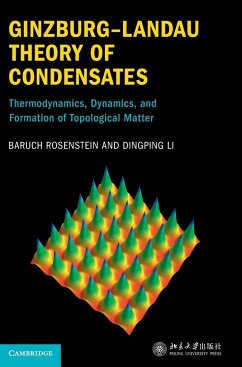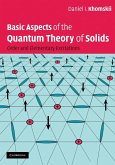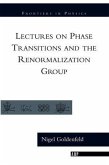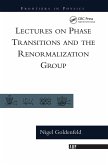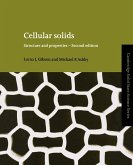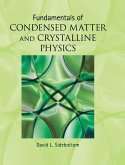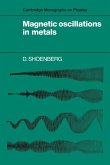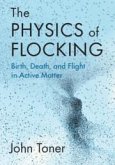- Gebundenes Buch
- Merkliste
- Auf die Merkliste
- Bewerten Bewerten
- Teilen
- Produkt teilen
- Produkterinnerung
- Produkterinnerung
In this systematic introduction to Ginzberg-Landau Theory, both common and topological excitations are considered on the same footing (including their thermodynamics and dynamical phenomena). This book is an important reference for researchers working in condensed matter physics and an advanced textbook graduate students.
Andere Kunden interessierten sich auch für
![Basic Aspects of the Quantum Theory of Solids Basic Aspects of the Quantum Theory of Solids]() Daniel I. Khomskii (The Netherlands Rijksuniversiteit Groningen)Basic Aspects of the Quantum Theory of Solids73,99 €
Daniel I. Khomskii (The Netherlands Rijksuniversiteit Groningen)Basic Aspects of the Quantum Theory of Solids73,99 €![Lectures On Phase Transitions And The Renormalization Group Lectures On Phase Transitions And The Renormalization Group]() Nigel GoldenfeldLectures On Phase Transitions And The Renormalization Group80,99 €
Nigel GoldenfeldLectures On Phase Transitions And The Renormalization Group80,99 €![Lectures On Phase Transitions And The Renormalization Group Lectures On Phase Transitions And The Renormalization Group]() Nigel GoldenfeldLectures On Phase Transitions And The Renormalization Group154,99 €
Nigel GoldenfeldLectures On Phase Transitions And The Renormalization Group154,99 €![Cellular Solids Cellular Solids]() Lorna J. Gibson (Massachusetts Institute of Technology Professor)Cellular Solids123,99 €
Lorna J. Gibson (Massachusetts Institute of Technology Professor)Cellular Solids123,99 €![Fundamentals of Condensed Matter and Crystalline Physics Fundamentals of Condensed Matter and Crystalline Physics]() David L. Sidebottom (Omaha Creighton University)Fundamentals of Condensed Matter and Crystalline Physics88,99 €
David L. Sidebottom (Omaha Creighton University)Fundamentals of Condensed Matter and Crystalline Physics88,99 €![Magnetic Oscillations in Metals Magnetic Oscillations in Metals]() D. ShoenbergMagnetic Oscillations in Metals80,99 €
D. ShoenbergMagnetic Oscillations in Metals80,99 €![The Physics of Flocking The Physics of Flocking]() John Toner (University of Oregon)The Physics of Flocking67,99 €
John Toner (University of Oregon)The Physics of Flocking67,99 €-
-
-
In this systematic introduction to Ginzberg-Landau Theory, both common and topological excitations are considered on the same footing (including their thermodynamics and dynamical phenomena). This book is an important reference for researchers working in condensed matter physics and an advanced textbook graduate students.
Produktdetails
- Produktdetails
- Verlag: Cambridge University Press
- Seitenzahl: 356
- Erscheinungstermin: 13. Oktober 2021
- Englisch
- Abmessung: 250mm x 175mm x 24mm
- Gewicht: 760g
- ISBN-13: 9781108836852
- ISBN-10: 1108836852
- Artikelnr.: 62297442
- Herstellerkennzeichnung
- Libri GmbH
- Europaallee 1
- 36244 Bad Hersfeld
- gpsr@libri.de
- Verlag: Cambridge University Press
- Seitenzahl: 356
- Erscheinungstermin: 13. Oktober 2021
- Englisch
- Abmessung: 250mm x 175mm x 24mm
- Gewicht: 760g
- ISBN-13: 9781108836852
- ISBN-10: 1108836852
- Artikelnr.: 62297442
- Herstellerkennzeichnung
- Libri GmbH
- Europaallee 1
- 36244 Bad Hersfeld
- gpsr@libri.de
Baruch Rosenstein is a professor at National Yang Ming Chiao Tung University at Hsinchu, Taiwan (ROC). His scientific interests in field theory and critical phenomena have gradually shifted toward condensed matter physics during postdoctoral experience at the University of Texas (Austin) and the University of British Columbia.
Preface. 1. Introduction and overview; Part I. Ordered Phases of Condensed
Matter Disrupted by Topological Defects: 2. The phenomenological (Landau)
description of the ordered condensed matter from magnets to Bose
condensates; 3. Simplest topological defects; 4. Topological defects and
their classification; Part II. Structure of the Topological Matter Created
by Gauge Field: 5. Repulsion between solitons and viable vortex matter
created by a gauge field; 6. Abrikosov vortices created by the magnetic
field; 7. Structure and magnetization of the vortex lattice within London
approximation; 8. Structure and megnetization of the vortex lattice within
Abrikosov approximation; Part III. Excitation Modes of Condensate:
Elasticity and Stability of the Topological Matter: 9. Linear stability
analysis of the homogenous states; 10. Stability and the excitation
spectrum of the single soliton and the vortex lattice; 11. Forces of
solitons, pinning and elasticity of the vortex matter; Part IV. Dynamics of
Condensates and Solitary Waves: 12. Dynamics of the order parameter field;
13. Solitary waves; 14. Viscous flow of the Abrikosov flux lattice; Part V.
Thermal Fluctuations. 15. Statistical physics of mesoscopic degrees of
freedom; 16. The Landau-Wilson approach to statistical physics of the
interacting field fluctuations; 17. Thermal fluctuations in the vortex
matter; Appendix; Index.
Matter Disrupted by Topological Defects: 2. The phenomenological (Landau)
description of the ordered condensed matter from magnets to Bose
condensates; 3. Simplest topological defects; 4. Topological defects and
their classification; Part II. Structure of the Topological Matter Created
by Gauge Field: 5. Repulsion between solitons and viable vortex matter
created by a gauge field; 6. Abrikosov vortices created by the magnetic
field; 7. Structure and magnetization of the vortex lattice within London
approximation; 8. Structure and megnetization of the vortex lattice within
Abrikosov approximation; Part III. Excitation Modes of Condensate:
Elasticity and Stability of the Topological Matter: 9. Linear stability
analysis of the homogenous states; 10. Stability and the excitation
spectrum of the single soliton and the vortex lattice; 11. Forces of
solitons, pinning and elasticity of the vortex matter; Part IV. Dynamics of
Condensates and Solitary Waves: 12. Dynamics of the order parameter field;
13. Solitary waves; 14. Viscous flow of the Abrikosov flux lattice; Part V.
Thermal Fluctuations. 15. Statistical physics of mesoscopic degrees of
freedom; 16. The Landau-Wilson approach to statistical physics of the
interacting field fluctuations; 17. Thermal fluctuations in the vortex
matter; Appendix; Index.
Preface. 1. Introduction and overview; Part I. Ordered Phases of Condensed
Matter Disrupted by Topological Defects: 2. The phenomenological (Landau)
description of the ordered condensed matter from magnets to Bose
condensates; 3. Simplest topological defects; 4. Topological defects and
their classification; Part II. Structure of the Topological Matter Created
by Gauge Field: 5. Repulsion between solitons and viable vortex matter
created by a gauge field; 6. Abrikosov vortices created by the magnetic
field; 7. Structure and magnetization of the vortex lattice within London
approximation; 8. Structure and megnetization of the vortex lattice within
Abrikosov approximation; Part III. Excitation Modes of Condensate:
Elasticity and Stability of the Topological Matter: 9. Linear stability
analysis of the homogenous states; 10. Stability and the excitation
spectrum of the single soliton and the vortex lattice; 11. Forces of
solitons, pinning and elasticity of the vortex matter; Part IV. Dynamics of
Condensates and Solitary Waves: 12. Dynamics of the order parameter field;
13. Solitary waves; 14. Viscous flow of the Abrikosov flux lattice; Part V.
Thermal Fluctuations. 15. Statistical physics of mesoscopic degrees of
freedom; 16. The Landau-Wilson approach to statistical physics of the
interacting field fluctuations; 17. Thermal fluctuations in the vortex
matter; Appendix; Index.
Matter Disrupted by Topological Defects: 2. The phenomenological (Landau)
description of the ordered condensed matter from magnets to Bose
condensates; 3. Simplest topological defects; 4. Topological defects and
their classification; Part II. Structure of the Topological Matter Created
by Gauge Field: 5. Repulsion between solitons and viable vortex matter
created by a gauge field; 6. Abrikosov vortices created by the magnetic
field; 7. Structure and magnetization of the vortex lattice within London
approximation; 8. Structure and megnetization of the vortex lattice within
Abrikosov approximation; Part III. Excitation Modes of Condensate:
Elasticity and Stability of the Topological Matter: 9. Linear stability
analysis of the homogenous states; 10. Stability and the excitation
spectrum of the single soliton and the vortex lattice; 11. Forces of
solitons, pinning and elasticity of the vortex matter; Part IV. Dynamics of
Condensates and Solitary Waves: 12. Dynamics of the order parameter field;
13. Solitary waves; 14. Viscous flow of the Abrikosov flux lattice; Part V.
Thermal Fluctuations. 15. Statistical physics of mesoscopic degrees of
freedom; 16. The Landau-Wilson approach to statistical physics of the
interacting field fluctuations; 17. Thermal fluctuations in the vortex
matter; Appendix; Index.

